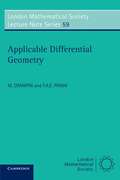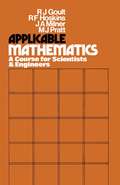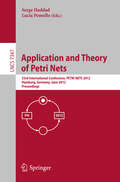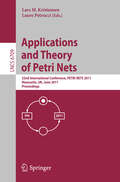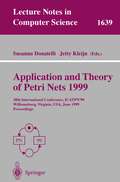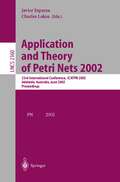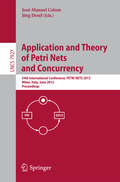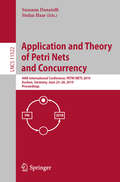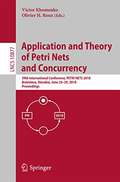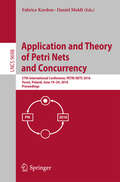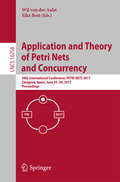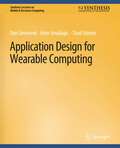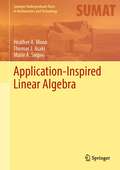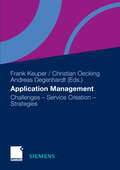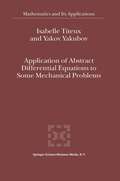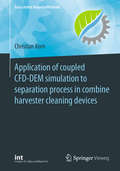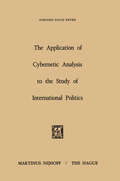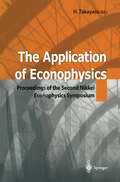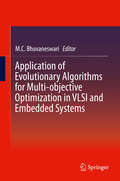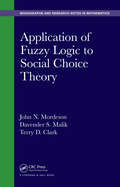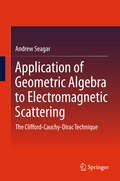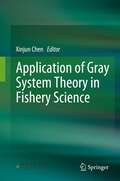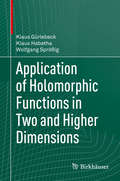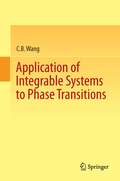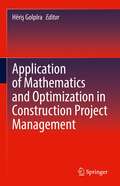- Table View
- List View
Applicable Differential Geometry (PDF)
by M. Crampin F. A. E. PiraniThis book is based on lecture courses given by the authors over the past decade and a half to various student audiences, most of them final year undergraduates or beginning graduates. It is meant particularly for those who wish to study relativity theory or classical mechanics from a geometrical viewpoint.
Application and Theory of Petri Nets: 33rd International Conference, PETRI NETS 2012, Hamburg, Germany, June 25-29, 2012, Proceedings (Lecture Notes in Computer Science #7347)
by Serge Haddad Lucia PomelloThis book constitutes the refereed proceedings of the 33rd International Conference on Applications and Theory of Petri Nets and Concurrency, PETRI NETS 2012, held in Hamburg, Germany, in June 2012. The 18 regular papers and 3 tool papers presented were carefully reviewed and selected from 55 submissions. The book also contains 2 invited talks. All current issues on research and development in the area of Petri nets and related models of concurrent systems are addressed.
Application and Theory of Petri Nets: 32nd International Conference, PETRI NETS 2011, Newcastle, UK, June 20-24, 2011, Proceedings (Lecture Notes in Computer Science #6709)
by Lars M. Kristensen Laure PetrucciThis book constitutes the refereed proceedings of the 32nd International Conference on Applications and Theory of Petri Nets and Other Models of Concurrency, PETRI NETS 2011, held in Newcastle, UK, in June 2011. The 13 regular papers and 4 tool papers presented were carefully reviewed and selected from 49 submissions. The book also contains 3 full paper length invited talks. All current issues on research and development in the area of Petri nets and related models of concurrent systems are addressed.
Application and Theory of Petri Nets 1999: 20th International Conference, ICATPN'99, Williamsburg, Virginia, USA, June 21-25, 1999 Proceedings (Lecture Notes in Computer Science #1639)
by Susanna Donatelli Jetty KleijnApplication and Theory of Petri Nets 2002: 23rd International Conference, ICATPN 2002, Adelaide, Australia, June 24-30, 2002. Proceedings (Lecture Notes in Computer Science #2360)
by Javier Esparza Charles LakosApplication and Theory of Petri Nets and Concurrency: 34th International Conference, PETRI NETS 2013, Milan, Italy, June 24-28, 2013, Proceedings (Lecture Notes in Computer Science #7927)
by Jose-Manuel Colom Jörg DeselThis book constitutes the refereed proceedings of the 34th International Conference on Applications and Theory of Petri Nets and Concurrency, PETRI NETS 2013, held in Milan, Italy, in June 2013. The 18 regular papers and 2 tool papers presented were carefully reviewed and selected from 56 submissions. The book also contains 2 invited talks. All current issues on research and development in the area of Petri nets and related models of concurrent systems are addressed.
Application and Theory of Petri Nets and Concurrency: 40th International Conference, PETRI NETS 2019, Aachen, Germany, June 23–28, 2019, Proceedings (Lecture Notes in Computer Science #11522)
by Susanna Donatelli Stefan HaarThis book constitutes the proceedings of the 40th International Conference on Application and Theory of Petri Nets and Concurrency, PETRI NETS 2019, held in Aachen, Germany, , in June 2018. Petri Nets 2019 is co-located with the 19th International Conference on Application of Concurrency to System Design, ACSD 2019.The 23 regular and 3 invited papers presented together in this volume were carefully reviewed and selected from 41 submissions. The focus of the conference is on following topics: Models, Tools, Synthesis, Semantics, Concurrent Processes, Algorithmic Aspects, Parametrics and Combinatorics, and Models with Extensions.
Application and Theory of Petri Nets and Concurrency: 39th International Conference, PETRI NETS 2018, Bratislava, Slovakia, June 24-29, 2018, Proceedings (Lecture Notes in Computer Science #10877)
by Victor Khomenko Olivier H. RouxThis book constitutes the proceedings of the 39th International Conference on Application and Theory of Petri Nets and Concurrency, PETRI NETS 2018, held in Bratislava, Slovakia, in June 2018. Petri Nets 2017 is co-located with the 19th International Conference on Application of Concurrency to System Design, ACSD 2018. The 15 regular and 8 tool papers, with 1 invited talk presented together in this volume were carefully reviewed and selected from 33 submissions. The focus of the conference is on following topics: Petri Nets Synthesis; Analysis and Model Checking; Languages; Semantics and Expressiveness; and Tools.
Application and Theory of Petri Nets and Concurrency: 37th International Conference, PETRI NETS 2016, Toruń, Poland, June 19-24, 2016. Proceedings (Lecture Notes in Computer Science #9698)
by Fabrice Kordon Daniel MoldtThis book constitutes the proceedings of the 37th International Conference on Application and Theory of Petri Nets and Concurrency, PETRI NETS 2016, held in Toruń, Poland, in June 2016. Petri Nets 2016 was co-located with the Application of Concurrency to System Design Conference, ACSD 2016.The 16 papers including 3 tool papers with 4 invited talks presented together in this volume were carefully reviewed and selected from 42 submissions. Papers presenting original research on application or theory of Petri nets, as well as contributions addressing topics relevant to the general field of distributed and concurrent systems are presented within this volume.
Application and Theory of Petri Nets and Concurrency: 38th International Conference, PETRI NETS 2017, Zaragoza, Spain, June 25–30, 2017, Proceedings (Lecture Notes in Computer Science #10258)
by Wil van der Aalst Eike BestThis book constitutes the proceedings of the 38th International Conference on Application and Theory of Petri Nets and Concurrency, PETRI NETS 2017, held in Zaragoza, Spain, in June 2017. Petri Nets 2017 is co-located with the Application of Concurrency to System Design Conference, ACSD 2017.The 16 papers, 9 theory papers, 4 application papers, and 3 tool papers, with 1 short abstract and 3 extended abstracts of invited talks presented together in this volume were carefully reviewed and selected from 33 submissions. The focus of the conference is on following topics: Simulation of Colored Petri Nets, Petri Net Tools.- Model Checking, Liveness and Opacity, Stochastic Petri Nets, Specific Net Classes, and Petri Nets for Pathways.
Application Design for Wearable Computing (Synthesis Lectures on Mobile & Pervasive Computing)
by Dan Siewiorek Asim Smailagic Thad StarnerThe confluence of decades of computer science and computer engineering research in multimodal interaction (e.g., speech and gesture recognition), machine learning (e.g., classification and feature extraction), software (e.g., web browsers, distributed agents), electronics (e.g., energy-efficient microprocessors, head-mounted displays), design methodology in user-centered design, and rapid prototyping have enabled a new class of computers—wearable computers. The lecture takes the viewpoint of a potential designer or researcher in wearable computing. Designing wearable computers requires attention to many different factors because of the computer’s closeness to the body and its use while performing other tasks. For the purposes of discussion, we have created the UCAMP framework, which consists of the following factors: user, corporal, attention, manipulation, and perception. Each of these factors and their importance is described. A number of example prototypes developed by the authors, as well as by other researchers, are used to illustrate these concepts. Wearable computers have established their first foothold in several application domains, such as vehicle and aircraft maintenance and manufacturing, inspection, language translation, and other areas. The lecture continues by describing the next step in the evolution of wearable computers, namely, context awareness. Context-aware computing takes into account a user’s state and surroundings, and the mobile computer modifies its behavior based on this information. A user’s context can be quite rich, consisting of attributes such as physical location, physiological state, personal history, daily behavioral patterns, and so forth. If a human assistant were given such context, he or she would make decisions in a proactive fashion, anticipating user needs, and acting as a proactive assistant. The goal is to enable mobile computers to play an analogous role, exploiting context information to significantly reduce demands on human attention. Context-aware intelligent agents can deliver relevant information when a user needs that information. These data make possible many exciting new applications, such as augmented reality, context-aware collaboration, and augmented manufacturing. The combined studies and research reported in this lecture suggest a number of useful guidelines for designing wearable computing devices. Also included with the guidelines is a list of questions that designers should consider when beginning to design a wearable computer. The research directions section emphasizes remaining challenges and trends in the areas of user interface, modalities of interaction, and wearable cognitive augmentation. Finally, we summarize the most important challenges and conclude with a projection of future directions in wearable computing. Table of Contents: Introduction / The Wearable Computing UCAMP / Design Guidelines for Wearable Computing / Research Directions / Conclusions and Future Challenges
Application-Inspired Linear Algebra (Springer Undergraduate Texts in Mathematics and Technology)
by Heather A. Moon Thomas J. Asaki Marie A. SnipesThis textbook invites students to discover abstract ideas in linear algebra within the context of applications. Diffusion welding and radiography, the two central applications, are introduced early on and used throughout to frame the practical uses of important linear algebra concepts. Students will learn these methods through explorations, which involve making conjectures and answering open-ended questions. By approaching the subject in this way, new avenues for learning the material emerge: For example, vector spaces are introduced early as the appropriate setting for the applied problems covered; and an alternative, determinant-free method for computing eigenvalues is also illustrated. In addition to the two main applications, the authors also describe possible pathways to other applications, which fall into three main areas: Data and image analysis (including machine learning); dynamical modeling; and optimization and optimal design. Several appendices are included as well, one of which offers an insightful walkthrough of proof techniques. Instructors will also find an outline for how to use the book in a course. Additional resources can be accessed on the authors’ website, including code, data sets, and other helpful material. Application-Inspired Linear Algebra will motivate and immerse undergraduate students taking a first course in linear algebra, and will provide instructors with an indispensable, application-first approach.
Application Management: Challenges - Service Creation - Strategies
by Anjali Arya Markus Böhm Bhaswar Bose Laurent Cerveau Andreas Degenhardt Petra Endholz Freddie Geier Frank Keuper Maximo Romero Krause Helmut Krcmar Stefanie Leimeister Irvathraya Madhukar Benedikt Martens Christian Oecking Christoph Riedl Benedikt Schmidt Christian Schulmeyer Florian Täube Frank Teuteberg Katja WolterA number of eminent authors take a look at aspects of application management from a range of practical and theoretical perspectives and present possible solutions for current challenges, demonstrating the close links between service creation and service management.
Application of Abstract Differential Equations to Some Mechanical Problems (Mathematics and Its Applications #558)
by I. Titeux Yakov YakubovPREFACE The theory of differential-operator equations has been described in various monographs, but the initial physical problem which leads to these equations is often hidden. When the physical problem is studied, the mathematical proofs are either not given or are quickly explained. In this book, we give a systematic treatment of the partial differential equations which arise in elastostatic problems. In particular, we study problems which are obtained from asymptotic expansion with two scales. Here the methods of operator pencils and differential-operator equations are used. This book is intended for scientists and graduate students in Functional Analy sis, Differential Equations, Equations of Mathematical Physics, and related topics. It would undoubtedly be very useful for mechanics and theoretical physicists. We would like to thank Professors S. Yakubov and S. Kamin for helpfull dis cussions of some parts of the book. The work on the book was also partially supported by the European Community Program RTN-HPRN-CT-2002-00274. xiii INTRODUCTION In first two sections of the introduction, a classical mathematical problem will be exposed: the Laplace problem. The domain of definition will be, on the first time, an infinite strip and on the second time, a sector. To solve this problem, a well known separation of variables method will be used. In this way, the structure of the solution can be explicitly found. For more details about the separation of variables method exposed in this part, the reader can refer to, for example, the book by D. Leguillon and E. Sanchez-Palencia [LS].
Application of coupled CFD-DEM simulation to separation process in combine harvester cleaning devices (Fortschritte Naturstofftechnik)
by Christian KornThis book discusses the application of the coupled CFD-DEM approach for simulating the separation of grain and material other than grain in combine harvester cleaning devices. Based on a literature study, it describes the most important influencing factors and presents a database for particle parameterization. It investigates the separation process in two steps with differing levels of process abstraction. The first step involves numerical separation in a vertically oscillating box with airflow, and in the context of a sensitivity study, investigates the effect of selected material, contact and operating parameters on the target variables’ separation time and grain purity. In the second step, the numerical separation process was performed in a 200 mm wide segment of a combine harvester cleaning device. The numerical results were then compared with experimental investigations in order to confirm the method’s applicability.
The Application of Cybernetic Analysis to the Study of International Politics
by S.D. BryenThis study could not have been written before Professor Karl Deutsch made his great contribution to political science in his book, The Nerves of Govern ment. In applying the concepts elaborated in that work to the study of inter national politics it has been necessary to interpret and, occasionally, add to the concepts developed by Professor Deutsch. I do not know whether Deutsch would accept these changes, modifications and interpretations. Here I can only say that I have attempted to stay in the same spirit that I think motivated Professor Deutsch's pioneering study. That spirit is expressed throughout his work. It is that "all studies of politics, and all techniques and models suggested as instrument of political analysis, have this purpose: that men should be more able to act in politics with their eyes open. " In completing this work lowe much to many. Mrs. Susan Schellenberg aided me in identifying sections of an earlier draft that were unclear and helped me test some of the ideas I added to Deutsch's work. Mr. Frederick Slutsky did some preliminary testing of the action system formulations em ployed in the third chapter by using quantitative methods. Particular gratitude is due to the committee who saw this manuscript as a dissertation at Tulane University. This committee, led by Professor Henry L. Mason, consisted of Professor Warren Roberts, Jr. ; Professor James D. Cochrane; Professor Jean M. Danielson and Professor John. S. Gillespie.
The Application of Econophysics: Proceedings of the Second Nikkei Econophysics Symposium
by Hideki TakayasuEconophysics is a newborn field of science bridging economics and physics. A special feature of this new science is the data analysis of high-precision market data. In economics arbitrage opportunity is strictly denied; however, by observing high-precision data we can prove the existence of arbitrage opportunity. Also, financial technology neglects the possibility of market prediction; however, in this book you can find many examples of predicted events. There are other surprising findings. This volume is the proceedings of a workshop on "application of econophysics" at which leading international researchers discussed their most recent results.
Application of Evolutionary Algorithms for Multi-objective Optimization in VLSI and Embedded Systems
by M. C. BhuvaneswariThis book describes how evolutionary algorithms (EA), including genetic algorithms (GA) and particle swarm optimization (PSO) can be utilized for solving multi-objective optimization problems in the area of embedded and VLSI system design. Many complex engineering optimization problems can be modelled as multi-objective formulations. This book provides an introduction to multi-objective optimization using meta-heuristic algorithms, GA and PSO and how they can be applied to problems like hardware/software partitioning in embedded systems, circuit partitioning in VLSI, design of operational amplifiers in analog VLSI, design space exploration in high-level synthesis, delay fault testing in VLSI testing and scheduling in heterogeneous distributed systems. It is shown how, in each case, the various aspects of the EA, namely its representation and operators like crossover, mutation, etc, can be separately formulated to solve these problems. This book is intended for design engineers and researchers in the field of VLSI and embedded system design. The book introduces the multi-objective GA and PSO in a simple and easily understandable way that will appeal to introductory readers.
Application of Fuzzy Logic to Social Choice Theory
by John N. Mordeson Davender S. Malik Terry D. ClarkFuzzy social choice theory is useful for modeling the uncertainty and imprecision prevalent in social life yet it has been scarcely applied and studied in the social sciences. Filling this gap, Application of Fuzzy Logic to Social Choice Theory provides a comprehensive study of fuzzy social choice theory.The book explains the concept of a fuzzy max
Application of Geometric Algebra to Electromagnetic Scattering: The Clifford-Cauchy-Dirac Technique
by Andrew SeagarThis work presents the Clifford-Cauchy-Dirac (CCD) technique for solving problems involving the scattering of electromagnetic radiation from materials of all kinds.It allows anyone who is interested to master techniques that lead to simpler and more efficient solutions to problems of electromagnetic scattering than are currently in use. The technique is formulated in terms of the Cauchy kernel, single integrals, Clifford algebra and a whole-field approach. This is in contrast to many conventional techniques that are formulated in terms of Green's functions, double integrals, vector calculus and the combined field integral equation (CFIE). Whereas these conventional techniques lead to an implementation using the method of moments (MoM), the CCD technique is implemented as alternating projections onto convex sets in a Banach space.The ultimate outcome is an integral formulation that lends itself to a more direct and efficient solution than conventionally is the case, and applies without exception to all types of materials. On any particular machine, it results in either a faster solution for a given problem or the ability to solve problems of greater complexity. The Clifford-Cauchy-Dirac technique offers very real and significant advantages in uniformity, complexity, speed, storage, stability, consistency and accuracy.
Application of Gray System Theory in Fishery Science
by Xinjun ChenThis book reviews the gray system and combines its latest research results in fishery science. The chapters cover the basic concept and theory of gray system, original data processing and gray sequence generation, gray correlation analysis, gray cluster analysis, gray system modeling, gray prediction, gray decision-making, and gray linear programming. The theory of gray system is a new cross-sectional discipline founded in 1982 by Professor Deng Julong, a well-known scholar in China. In recent decades, it has not only been deepened and expanded in theory but also widely used in the fields of society, economy, ocean, agriculture, fishery, and other fields, and made a series of significant scientific achievements. These have laid the foundation for the important position of the gray system theory. Due to the great uncertainty of the fishery resources and the fishery environment involved in the fishery science system, which is completely different from the natural resources on the land, the data and information belong to the category of “poor information”, and the variability and uncertainty are greater than other natural resources. As an extremely effective analytical method and tool, gray system theory has been applied increasingly in fishery science. The book is developed based on well-read and practical literature and will help scientists and research units engaged in scientific research and teaching in fishery science and related fields to develop new research methods and tools.
Application of Holomorphic Functions in Two and Higher Dimensions
by Klaus Gürlebeck Klaus Habetha Wolfgang SprößigThis book presents applications of hypercomplex analysis to boundary value and initial-boundary value problems from various areas of mathematical physics. Given that quaternion and Clifford analysis offer natural and intelligent ways to enter into higher dimensions, it starts with quaternion and Clifford versions of complex function theory including series expansions with Appell polynomials, as well as Taylor and Laurent series. Several necessary function spaces are introduced, and an operator calculus based on modifications of the Dirac, Cauchy-Fueter, and Teodorescu operators and different decompositions of quaternion Hilbert spaces are proved. Finally, hypercomplex Fourier transforms are studied in detail. All this is then applied to first-order partial differential equations such as the Maxwell equations, the Carleman-Bers-Vekua system, the Schrödinger equation, and the Beltrami equation. The higher-order equations start with Riccati-type equations. Further topics include spatial fluid flow problems, image and multi-channel processing, image diffusion, linear scale invariant filtering, and others. One of the highlights is the derivation of the three-dimensional Kolosov-Mushkelishvili formulas in linear elasticity. Throughout the book the authors endeavor to present historical references and important personalities. The book is intended for a wide audience in the mathematical and engineering sciences and is accessible to readers with a basic grasp of real, complex, and functional analysis.
Application of Integrable Systems to Phase Transitions
by C.B. WangThe eigenvalue densities in various matrix models in quantum chromodynamics (QCD) are ultimately unified in this book by a unified model derived from the integrable systems. Many new density models and free energy functions are consequently solved and presented. The phase transition models including critical phenomena with fractional power-law for the discontinuities of the free energies in the matrix models are systematically classified by means of a clear and rigorous mathematical demonstration. The methods here will stimulate new research directions such as the important Seiberg-Witten differential in Seiberg-Witten theory for solving the mass gap problem in quantum Yang-Mills theory. The formulations and results will benefit researchers and students in the fields of phase transitions, integrable systems, matrix models and Seiberg-Witten theory.
Application of Mathematics and Optimization in Construction Project Management
by Hêriş GolpîraThis book provides a broad overview of project and project management principles, processes, and success/failure factors. It also provides a state of the art of applications of the project management concepts, especially in the field of construction projects, based on the Project Management Body of Knowledge (PMBOK). The slate of geographically and professionally diverse authors illustrates project management as a multidisciplinary undertaking that integrates renewable and non-renewable resources in a systematic process to achieve project goals. The book describes assessment based on technical and operational goals and meeting schedules and budgets.
